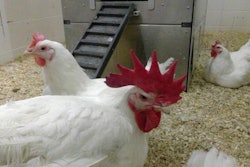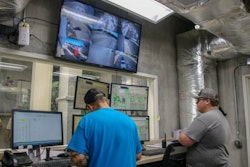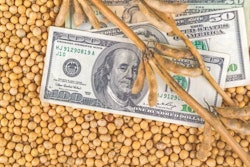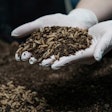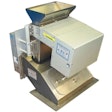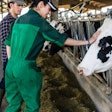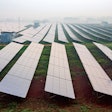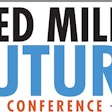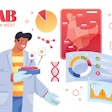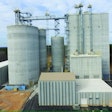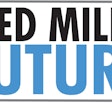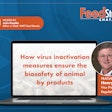Panel discusses how new technologies, recent trends will shape feed mill designs and equipment applications moving forward
Much can be gained by prognosticating about how current technologies and trends may shape industries in the future. Panelists during the “Imagining the feed mill of the future” panel discussion at the 4th Feed Strategy Conference, co-located with the International Production and Processing Expo (IPPE) in Atlanta on January 25, 2022.
Here, animal feed industry stakeholders explored topics ranging from light-out feed mill operation to the importance of sensors and data collection.
In case you missed the live event, here is your opportunity to watch the video or read the event’s transcript below.
Transcript of “Imagining the feed mill of the future” panel discussion at the 2022 Feed Strategy Conference
Moderator:Elise Schafer, editor, Feed & Grain magazine
Panelists:
- Scott Anderson, general sales manager, California Pellet Mill (CPM)
- Peter Ensch, CEO, WEM Automation LLC
- Aidan Connolly, AgriTech Capital
- Loren Field, executive vice president, Younglove Construction
Elise Schafer, editor, Feed & Grain magazine:So thank you, gentlemen, for agreeing to be on our panel. And this is meant to be a discussion and dialogue. So please come forward to the mic or raise your hand from there with your questions. But I’ll start off with a few thought-provoking questions of my own. So, reflecting on the past periods of growth in the feed industry, they’re usually spurred by a novel challenge, like the BSE crisis, antibiotic resistance orSalmonellaoutbreaks.What do you think is the next great challenge we’re facing today?
Aidan Connolly, AgriTech Capital:We’re certainly at a momentous moment in our history. And this labor issue that we have is immense. It’s clear that while we need people to work in processing plants, we need people to milk cows, we need people to work in feed mills. It’s just not a career that’s as attractive as perhaps we perceive it to be and the salaries don’t make it attractive for people who otherwise wouldn’t choose it. So everything to do with labor has become a huge issue for our industry as a whole. And that’s where I see the investment in technology going at the moment.
The pandemic has just accelerated that. It certainly made it more critical to find the people to replace the people who’ve left or are sick. So I think robotics, sensors, the use of camera vision, artificial intelligence — these are all just being accelerated by what we’ve seen in the recent past. But those trends were already there.
And you still, I’m going around the world, I still go to feed mills, go to feed mills in China, producing 100,000 tons of feed, and you can see 140 people working in the factory. And yet that same feed mill could be run with, I don’t know, gentlemen, one and a half, two people, perhaps on the shift in other parts of the world, it’s very clear where we’re going. And so that that is the big thing, I think is the big trend is elimination of labor as much as we can.
Schafer:Scott, anything to add?
Scott Anderson, general sales manager, California Pellet Mill (CPM):No. I couldn’t have said it better. I think that, you know, from the equipment side, that’s the challenge that the equipment manufacturers need to pick up. And as I look at the different business models of the future, interfacing with technology is certainly the critical, limiting factor on that ability, things like predictive maintenance, remote support and balancing those challenges with cybersecurity concerns, I think will be a primary issue going forward.
Schafer: Consumers — or prosumers — and food companies alike are demanding greater traceability in the livestock farm chain, and they want greater visibility and access to data. Is this a concern or an opportunity? And how does blockchain play into this?
Peter Ensch, CEO, WEM Automation LLC:Well, I mean, I would certainly agree. With Aidan’s prior comments around around labor, I would say the other big trend that we’re seeing is around data. So I think it’s really more of an opportunity than it is a challenge. Because there’s so much more we can do if we actually make use of the data that is even available to us now, let alone if we actually start doing more IoT and gathering more data from sensors down on the equipment level.
So I think that, you know, the big challenge is how do you take that data and turn it into useful information. And that’s where the analytics piece comes in too. So it’s pretty easy to just gather gigs of data right now, but actually trying to turn that into information that you can actually make business decisions with is really the challenge.
Connolly:And I can take it a little bit further. To me, there is this belief that more data is good. And with more data, the algorithms will become self learning. That was not my experience, you have to curate your data, you have to clean the data, you have to remove extraneous data. Otherwise, your algorithms start to drift and start to produce sensors that you’re not looking for. So yeah, we absolutely need more data, we also need systems for making sure that we’re restoring is the right data. Otherwise, we end up generating the wrong answers.
Ensch:I think that’s where it’s going to shift is, you know, the the industry is going to need a higher skill set to be able to do some of that analytics. So I think that’s gonna be the other other challenge is how do we actually recruit some of those folks into these businesses that they can do that type work?
Schafer: Absolutely. Now how do you expect the consolidation of feed businesses to impact feed mills of the future? Do you see fewer larger facilities, smaller mills specific by species or by region?
Loren Field, executive vice president, Younglove Construction:基本上我们看到两种不同的商业模式ls related to feed mill design, and feed milling companies. The integrated feed mills that are being designed and built today are getting larger and larger and larger with respect to throughput, fewer formulations, large runs a feed 1,000 times over 1,000 tons at a time without shutting the pellet mill down. That’s one business model.
The other is the smaller, full-line, bagged feed mill, we call it a retail feed mill, where they’re going to make feed for show animals or hobby farmers. And there doesn’t seem to be much in between.
So you’re going to see the integrated model and you’re going to see the retail model — and that is about where it’s going as far as we can see from the designs that we are being asked to produce.
The one caveat to that is that we are seeing larger facilities for organics starting to be requested. And the organic market is growing, and that is going to start to scale to the point where a feed mill for organic feed, it can be a standalone, economical unit.
Connolly:I remember thinking about this a lot when I started my career 30 years ago and thinking where we’re just going to end up with an awful lot of million-ton-per-year feed mills. And to take your point, I think we have seen some of those, it’s specialized. But a big trend I see is that the distance of the feed mill to the farm has been reduced tremendously.
Whereas 20 to 30 years ago, it was nothing to consider shipping feed 100 or 150 miles, most of the situations I see nowadays, that radius is very, very narrow. All around the world. And people are not sticking feed into trucks or sticking onto trains. They’re trying to be able to put it in a custom delivery truck that gets it there in 20, 25 miles.
Schafer: Let’s talk about the distribution of feed. How is this likely to change in the next five to 10 years? Do you see self ordering feed bins? Would you imagine feed being made more on the farm?
Ensch:I think you’re seeing that. There’s a couple of examples out there now where it’s it’s starting to look at like some other industries, like if you’re ordering concrete or asphalt, you’re jumping online, you’re placing an order, it’s automatically going into a work schedule. There’s usually a human involved there to try and to do some consolidation of orders and a little bit of black magic to kind of balance things out. But there’s definitely more automation and more tracking. So you’re going to be getting text messages to show that your order is on its way. The industry is going to catch up with all other industries when it comes to automating that front- and back-end process.
Connolly:I think you can imagine drone delivery of feed. I mean, it is certainly technically possible today, we have drones being produced in China that can carry up to up to two tons and considerable distances. And when you get into some of the markets, maybe where the infrastructure isn’t quite so good — and clearly I’m thinking of Africa — the ability to cut straight across the countryside and not have to go down a road will be immensely, immensely important.
So I see lots of ways, but yet the automation, the why do we have somebody looking to feed them to decide when to order? Why, unfortunately, I’m sure maybe there’s some sensor companies in the audience. But I think some of the sensor systems haven’t gotten to where we want them or where we need them to get to. But when they started as it will be a very powerful technology, and will remove a lot of that human interaction, which is where the mistakes are made today.
Schafer: What’s your, to talking about sensors and the role of nutritionists, do you see new technologies like NIR replacing that role? Scott, we’ve talked about this earlier.
Anderson:So certainly that capabilities of NIR to create access to alternative ingredients is there — and it’s there today — but it will butt up against the challenge of limited storage space in the feed mill. You have a certain number of ingredient bins, you don’t have a whole world of ingredients to choose from, you know, on a given day, so the nutritionists will be critical, of course, to decide what mix of ingredients are going to be available. But a truly customized ration is certainly envisioned in a small-batch capability.
Connolly:But if you want to fire up an audience on this subject, you say, do we really need nutritionists at all? Then you start entering into what artificial intelligence could do and where we’re going in the future. That’s usually when you get escorted from the room and out before somebody kills you. But there’s lots of interesting things that could happen, I think, really, I think, definitely the ability to use NIR, there’s lots of other infrared, lots of other spectral systems we could be using to look at the ingredients and to look also contaminants.
Schafer: Yes, you mentioned the nutritionist. What about it? There’s talk about eventually feed mills being run out of remote offices. And, Pete, maybe can you talk about a future where, on the operation side, automation takes that role?
Ensch:是的,它绝对是点的讨论。所以我们talked with several producers during COVID, when everyone was going home, working remote, and have had discussions of setting up central control centers that would be controlling multiple feed mills from a central location. So those discussions are starting right now. There’s challenges with that, with internet connectivity throughout the country, and being able to have the speed to be able to manage the control piece of it.
But those those discussions are happening. They also see that it might be easier just to have that pool of resources at one central location, so it’s easier to share those people as needed. So, yeah,it’s definitely of interest to some people and the technology’s there. It’s just pulling it together.
On the lights-out comment, I definitely see that coming as well. I think the challenge for the feed industry is it’s going to push people to have to move to that next level of preventative maintenance. If you want to run a facility lights-out, you can’t be having electrical and mechanical outages. So I think that that will be a challenge for folks to get to that next level from a maintenance standpoint.
Schafer: Scott, how is the equipment manufacturing side addressing that?
Anderson:所以我们’re continuing to engineer new technologies to help the equipment, the pellet mill in particular, which tends to be the most fussy machine in the feed mill to make it more reliable, reduce the amount of slips and plugs.
Sadly, I think we’re a long ways away from getting to that point where the pellet mill can be truly hands off. You know, if you look at some of the challenges that we have, we’re still measuring temperature and a conditioner is an analogue for moisture, because there aren’t, you know, moisture sensors suitable for the job yet or at least not affordable. So there’s some fundamental challenges. And then, of course, the challenge of just, you know, sometimes you just have to open the door and dig out a pellet mill after an upset. And unfortunately, we’re farther away than we’d like to be, say, we could be on getting to the point where it’s truly hands off.
Schafer: Loren, what about from a facility design aspect?
Field:Are there any changes you’re seeing, because of a lights-out concept? We haven’t really seen anybody embrace that yet. That is really a quantum leap, I think from the way mills are being built and operated today. Some of Peter’s comments about remote control rooms, that technology is there, but as far as the equipment maintenance function, we think that wherever there’s a mechanical piece of equipment, there’s going to be a broken piece of mechanical equipment at some point time. And human hands are going to have to touch that.
And so I think that’s in large measure why we’ve not seen the owner basis of the feed milling industry in the United States embrace that yet.
Anderson:It sort of interacts with the whole artificial intelligence piece, which is a challenge that the equipment folks need to take up to improve our capability for predictive maintenance. So that we can help our customers address situations before they get to the breakdown. And as Pete mentioned, the ability to harvest mountains of data is one thing, but learning how to convert that data into actionable intelligence is yet another challenge.
而且,你知道,轴承是一个很好的例子using a combination of vibration and temperature sensors, which technology currently exists today is one of the sort of the low hanging fruit that certainly our companies focused on, and I’m sure all of them are.
谢弗:现在,交通方面and the driver’s role in potential pathogenic spread? We’ve been talking about automation, what about autonomous or self-driving trucks, or other disinfecting options?
Field:Well, the technology for an autonomous self-driving truck someday will exist. We’ve not seen that yet in the U.S. at least.
One of the comments I’d like to make here regarding trucks, or truck drivers in particular, is we’re starting to see feed companies have their truck drivers stay in their truck. In large measure, a truck driver, what they’re telling us is truck drivers drive trucks, they do not load feed trucks. And by having them stay in their truck, they will haul more feed, which is important. As well, they do not spread biosecurity issues in the feed mill.
Since the truck is also a carrier of biosecurity issues, we think that there’s going to have to be an issue addressed related to either wash down in the truck, very often, or some type of heat sterilization that is commonly used inside flour mills. However, that takes a good bit of time and will drive costs up at this point in time. But that’s what we’re seeing right now.
Connolly:Yeah, maybe just take slightly different direction that I know I was at a conference here a couple of years ago and talking about replacing antimicrobials in feed and how do you get to antibiotic free. One of his contentions is that you own or you service all the farms on one road, you don’t have some farms on your system and some farm and another integrated system. That’s when the infection issue started and just brought home to me once again, how critical it is to control the trucking systems, and how easy it is for a truck to bring problems from one farm to another farm.
So yeah, aside from anything else, I think as we see more integrated systems, as we see areas of the country and areas of the world be more and more specialized by species, I think the idea that we’re going to minimize the potential for passage from one farm to another through the choices we make, making sure that they’re all coming from the same feed mill, being delivered as much as possible on the similar road. These are all critical parts of this simple things that can be done before we even embrace technology.
Audience question: What has been the impact in the feed industry of black soldier flies as an alternative to other animal-based protein and plant-based proteins? You have particular for costs and production in laying hens?
Connolly:So far, and as with many agri technologies, great promise hasn’t delivered yet. The costs of production of black soldier fly larvae, by the time you go through the system, still simplistically to my mind around about $3 a kilo. So that’s not going to replace soybean meal anytime soon. It’s not going to replace fishmeal anytime soon. The secondary challenge with it is, in order to get consistent amino acid or consistent nutritional profile, you need to be feeding a consistent material. And of course, we’re using the cheapest material we can find. So we’re using food waste, we’re using distillery waste for using, you know, variety but it’s the material being fed to the flies is not consistent. So the fly meal then isn’t as consistent. And the yields that you get from that type of production.
So I think we’ve got some ways to go. I’ve got a friend of mine who invests with me. And his phrase, which is memorable, but not very nice. As he said, the only way to make black soldier fly larvae or indeed any insect meal, is to feed it poop. You need material, which is as cheap as possible. And of course, when you start thinking about manures, you start thinking about it, you know what that might be, then you bring in all sorts of other potential contaminants as well. So it’s a very fragile system. I think it clearly has a lot of potential. There are some big, big, big investors, you know, Darling Industries here in the U.S. doing big things, seen as in other parts of the world as well, but I just haven’t seen anybody get it to a level where we’re ready to feed it to laying hens.
Schafer: Now, climate change and sustainability will be a cornerstone of the current administration and become an even higher concern for consumers in the coming years. What does the feed industry need to do to be viewed as a more sustainably conscious industry?
Ensch:I think one of the starting points is looking at energy monitoring and energy management. So the technology is out there. It’s used in a number of other industries. It’s a matter of just installing sensors, meters, sub meters, and capturing what energy you’re using and going through the class of Pareto analysis of what are your big users and trying to reduce your consumption.
I think, you know, certainly in the U.S., we’ve been blessed with very cheap energy over the years so it has not been that large of a concern. But when you start letting the sustainability argument come over, I think it’s going to be a greater focus going forward.
Schafer: Scott, what about from an equipment manufacturer’s perspective?
Anderson:I guess the point I’d like to make first is that, I think one of the first things that the feed industry needs to get better at is just telling our story. And, you know, we historically have sort of circled the wagons whenever there’s, you know, folks looking at the outside, or looking from the outside, and we just need to get better at messaging, some of the great things that we’re already doing, you know, for a sustainable future.
On the equipment side, there are a number of things that, you know, we can do both in terms of material sourcing, thinking in terms of shorter supply chains. You know, for example, more recycled materials, you know, we’re a company that makes iron — or bends iron — and, you know, metal is already one of the, you know, best recyclers in the world, you know, so it’s a good starting point.
And then we can help our customers by integrating with technologies and automation, so that equipment is run the most efficiently. This would be things like, knowing the economical number of starts and stops for large motors. You know, if you have a, you know, a pellet mill with as big as 800 horsepower on it, you know, how long should you anticipate running it idle before it makes sense to turn it off, and then turn it back on again later.
And this is where, you know, we need collaborations with both utility companies with the automation companies, so that we can, you know, warn our clients that OK, you know, this machine’s been idling for 20 minutes, it’s time to shut it off or start a new batch.
Connolly:And also maybe just suggest something more contentious, which is, when you look through some of these climate change numbers, one of the most surprising things to me that nobody seems to discuss is the impact cement is having on the planet. It uses a tremendous amount of energy. Wonder whether we could reimagine building, building feed mills, Loren, with no cement. Is that possible?
Field:Yes. Of course, there are alternative building materials to concrete, steel, of course, is one of them. There are many, many steel facilities out there. Interesting that you brought that up. And because next year, or no, this year, they are going to cement companies are going to mix 10% of their cement is going to be lime crushed up lime dust. And we’ll have to see what that does to the strength of concrete, but they are making an attempt to lower the environmental footprint on cement already. So we’ll see how that goes. We’ll have more to report as time goes on.
Schafer: We’ve got a couple more minutes. Are there any other audience questions?
Audience question: Speaking of sustainability, we’ve talked about larger feed mills, which always makes me wonder about having to have the delivery trucks drive farther? How do we balance the sustainability of the advantage of the larger mill versus potentially longer drives for delivery?
Ensch:It really comes down, it’s a logistics issue. I mean, I think you got to put the feed mills where the animals are. And that’s what we see in most countries. So anything we can do to is prior comment of, you know, having a given feed mill produced for, you know, a series of farms on a very small path. I think we see that here in this in this country. It was a great example of there’s not much feed distributed more than 30 miles in Iowa.
I think it can been done, but it’s just a matter of getting the logistics around animals and feed production.
Connolly:是的,我同意。我认为我必须写一篇论文for the Chinese feed industry about six years ago describing what the future was going to look like. So I used you know, used the experience of the U.S. has the experience of Europe and I think it’s happening anyway. Where those radius I’ve described that distance to from the feed mill to to the farm is being reduced organically anyway.
Ensch:And then the processing facilities to I mean, China’s reinventing their, their swine industry.
谢弗:一个问题所有的小组成员, you all have a different perspective in the industry, what are your customers investing in, that’s cutting edge or innovative?
Anderson:Really, there’s a lot of interest in anything we can do to help the equipment be more hands off. So more sensors. And just looking for a lot of help in, again, getting back to the predictive maintenance aspect. And, you know, interfacing, that predictive maintenance with supply chain, automatic reordering, automatic parts ordering that sort of thing. So I think that’s something that’s on the pretty near horizon.
Ensch:I would agree it’s about data integration is where I see a lot of so it’s a lot of software investment, and getting all these different systems to talk. So it’s getting everything out from the production level maintenance systems, truck management systems, warehouse management systems, there’s a lot of investment that goes on just simply to connect all these different software packages and get the data to flow back and forth. So a lot of IT investments that that I see right now.
Connolly:And I think that hasn’t been done very well. So far, at least in the feed industry, there isn’t a single package you can purchase or single package you can use to take all these data flows and put them together. It’s a massive business opportunity.
And I know some companies are trying to do it. I know some feed companies are trying to do it. But I feed my level, when I’ve asked, I’m surprised at how little money is being spent on data, compared to every other business I know, and yet how critical it is. Because you can’t deal with seven or eight apps, if you’re running a feed mill, you don’t want to have every equipment manufacturer’s app giving you different data flows.
Also, just because I’ve been reflecting a little bit on this recently, this extended reality, the so-called metaverse that we’re starting to hear about, the idea we could be wearing Google Goggles or using virtual reality to train people and starting to see a lot more applications of that, virtual reality certainly being used to train farmers as to how to use equipment on the farm. So why not speed up the process of training people in the feed mill as well, or at least giving them furthermore information as they walk around.
So I think that there’s some extended reality is going to offer some really interesting opportunities as well.
Field:Right, on the bricks-and-mortar front, our customers are, about half our jobs, our customers are wanting to invest in more sanitary designs. And that means box beams without ledges on structural steel course. We’re a concrete builder. So the vertical structural members that we provide with concrete are definitely a benefit.
On the safety side, our customers are replacing ladders with stairs. That is a substantial investment in safety and I think it’s a substantial investment in trying to retain feed mill employees. I would certainly rather carry a toolbox up a set of stairs than a ladder.
Dovetailing with that, we are also installing fall protection beams and fall protection equipment, certainly above railroad cars, and a lot of times in areas where like above a mixer.
We’re providing more and larger access platforms. So that can be done a lot easier and safer. And we are also seeing companies invest in railcar openers that the employee can ride on instead of push around to a two-wheel cart.
I mean, these are all things that are very low tech compared to what these guys are talking about. But nonetheless, that is what our customer base is asking for in the designs that we’re producing for the feed mill industry.
Schafer:OK, are there any other questions for our panelists? OK, well, I want to thank you all for your insights and sharing your different perspectives.





